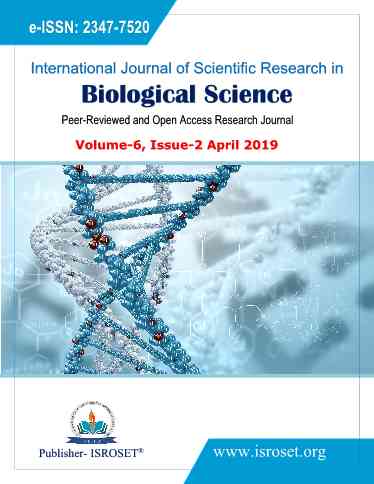Microbial analysis of water bodies near food industries
Keywords:
E. coli, Enterobacter sp, Klebsiella sp, Microbial analysisAbstract
The quality of water and occurrence of water borne diseases are critical public health issues. The most serious public health risk associated with drinking water is microbiological contamination thereby making it a priority for water quality testing. The objective of the study was to assess the quality of drinking water by isolation and enumeration of organisms through microbiological examination. Water samples were collected from four different regions - North, South, East and Central Kolkata. Microbial and fermentation tests were performed in the collected water samples followed by confirmatory IMViC tests to detect the presence of microorganisms. Microbial estimations indicated the presence of coliforms in water which may lead to diseases like diarrhoea and gastrointestinal problems. The biochemical tests also displayed the occurrence of the members of the Enterobacteriaceae family including E.coli, Enterobacter sp and Klebsiella sp. These microorganisms deteriorate the quality of drinking water making it unfit for human consumption. Therefore, accurate testing of drinking water is crucial in maintaining the health and safety of inhabitants who rely on this resource.
References
C.M. Noorjahan, “Physicochemical characteristics, identification of bacteria and biodegradation of industrial effluent”, Journal of Bioremediation and Biodegradation, Vol.5, No.3, pp.1-5, 2014.
S.S. Purewal, N. Kumar, P. Ganguly, and M.K. Jogi, “Qualitative analysis of water samples collected from different locations of Jaipur, Rajasthan, India”, International Journal of Current Research, Vol.6, No.3, pp.5681-5683, 2014.
S. Gyawali, K. Techato, and C. Yuangyai, “Effects of Industrial Waste Disposal on the Surface Water Quality of U-tapao River, Thailand”, In the Proceedings of the 2012 International Conference on Environment Science and Engineering, pp.109-113, 2012.
D. Briggs, “Environmental pollution and the global burden of disease”, British Medical Bulletin, Vol.68, No.1, pp.1-24, 2003.
L.S. Durge, A.M. Chilke, and R.N. Chavhan, “Physico-Chemical Analysis of Waste Water from ACC Cement Industry from an Industrial Town – Ghugus (Maharashtra), India”, International Journal of Scientific Research in Biological Sciences, Vol.6, No.1, pp.240-242, 2019.
T.G. Amabye, “Effect of food processing industries effluents on the environment: A case study of MOHA Mekelle bottling company, Tigray, Ethiopia”, Industrial Chemistry, Vol.1, No.2, pp.1-4, 2015.
A. Husain, M.M. Ashhar, and I. Javed, “Analysis of industrial wastewater in Aligarh city”, Journal of Chemical and Pharmaceutical Research, Vol.6, No.1, pp.614-621, 2014.
U. Szewzyk, R. Szewzyk, W. Manz, and K.H. Schleifer, “Microbiological safety of drinking water”, Annual Review of Microbiology, Vol.54, pp.81-127, 2000.
L. Manning, “The impact of water quality and availability on food production”, British Food Journal, Vol.110, No.8, pp.762-780, 2008.
M. Barabde, and S. Danve, “Real time water quality monitoring system”, International Journal of Innovative Research in Computer and Communication Engineering, Vol.3, No.6, pp.5064-5069, 2015.
M.M. Bumadian, H.H. Almansury, I.H. Bozakouk, Y.F. Lawgali, and F.L. Bleiblo, “Detection and enumeration of coliform bacteria in drinking water at hospital of Benghazi/Libya”, Journal of Experimental Biology and Agricultural Sciences, Vol.1, No.6, pp.436-440, 2013.
H. Seckin, “Investigation of Coliform And E. Coli Bacteria And Nitrite And Nitrate Levels İn Drinking Waters of Van And Some Provinces”, International Organization of Scientific Research Journal of Environmental Science, Toxicology and Food Technology, Vol.12, No.14, pp.47-50, 2018.
R.T. Murray, R.E. Goldstein, E.F. Maring, D.G. Pee, K. Aspinwall, S.M. Wilson, and A.R. Sapkota, “Prevalence of Microbiological and Chemical Contaminants in Private Drinking Water Wells in Maryland, USA”, International Journal of Environmental Research and Public Health, Vol.15, No.1686, pp.1-13, 2018.
J.S. Gruber, “Coliform Bacteria as Indicators of Diarrheal Risk in Household Drinking Water: Systematic Review and Meta-Analysis”, PLoS One, Vol.9, No.9, pp.1-14, 2014.
A.E. Fakhr, “Impact of Some Ecological Factors on Fecal Contamination of Drinking Water by Diarrheagenic Antibiotic-Resistant Escherichia coli in Zagazig City, Egypt”, International Journal of Microbiology, Vol.2016, No.3, pp.1-9, 2016.
A. Haleem, “Evaluation of Microorganisms of Drinking Water of Rafha City, Northern Borders, Saudi Arabia”, Journal of Cytology and Histology, Vol.7, No.3, pp.1-7, 2016.
V. Hemraj, D. Sharma, and A. Gupta, “A review on commonly used biochemical test for bacteria”, Innovare Journal of Life Science, Vol.1, No.1, pp.1-7, 2013.
A. Kaur, S. Vats, S. Rekhi, A. Bhardwaj, J. Goel, R.S. Tanwar, and K.K. Gaur, “Physico-chemical analysis of the industrial effluents and their impact on the soil microflora”, Procedia Environmental Sciences, Vol.2, pp.595-599, 2010.
R. Amin, S.S. Ali, Z. Anwar, and J.Z.K. Khattak, “Microbial Analysis of Drinking Water and Water Distribution System in New Urban Peshawar”, Current Research
Downloads
Published
How to Cite
Issue
Section
License

This work is licensed under a Creative Commons Attribution 4.0 International License.
Authors contributing to this journal agree to publish their articles under the Creative Commons Attribution 4.0 International License, allowing third parties to share their work (copy, distribute, transmit) and to adapt it, under the condition that the authors are given credit and that in the event of reuse or distribution, the terms of this license are made clear.







